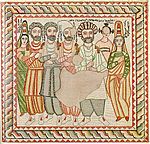Assyrian Genocide
| Assyrian genocide | |
|---|---|
| Part of the persecution of Assyrians | |

A report published in the Washington Times on March 26, 1915.
|
|
| Location |
|
| Date | 1914–1920 |
| Target | Assyrian civilians |
|
Attack type
|
Deportation, mass murder, etc. |
| Deaths | 150,000–300,000 (see death toll section below) |
| Perpetrators | Young Turk government, Kurdish tribes |
History of the Assyrian people
Old Assyrian Empire (20th–15th c. BCE)
Neo-Assyrian Empire (911–612 BCE)
Achaemenid Assyria (539–330 BCE)
Seleucid Empire (312–63 BCE)
Parthian Empire (247 BCE – 224 CE)
Osroene (132 BCE – 244 CE)
Syrian Wars (66 BCE – 217 CE)
Roman Syria (64 BCE – 637 CE)
Adiabene (15–116)
Roman Assyria (116–118)
Christianization (1st to 3rd c.)
Nestorian Schism (5th c.)
Asōristān (226–651)
Byzantine–Sasanian wars (502–628)
Muslim conquest of Persia (630s-640s)
Abbasid Caliphate (750–1258)
Emirs of Mosul (905–1383)
Buyid amirate (945–1055)
Principality of Antioch (1098–1268)
Ilkhanate (1258–1335)
Jalairid Sultanate (1335–1432)
Kara Koyunlu (1375–1468)
Ağ Qoyunlu (1453–1501)
Safavid dynasty (1508-1555)
Ottoman Empire (1555–1917)
Schism of 1552 (16th c.)
Massacres of Badr Khan (1840s)
Massacres of Diyarbakir (1895)
Rise of nationalism (19th c.)
Adana massacre (1909)
Assyrian genocide (1914–1920)
Assyrian independence movement (since 1919)
Simele massacre (1933)
Post-Saddam Iraq (since 2003)
...
Wikipedia

